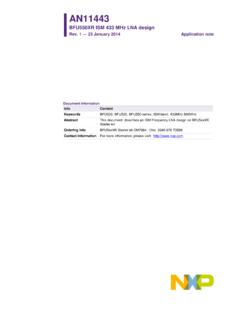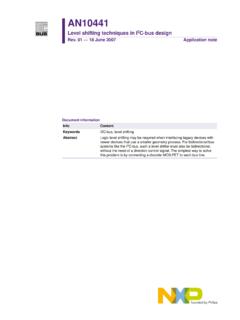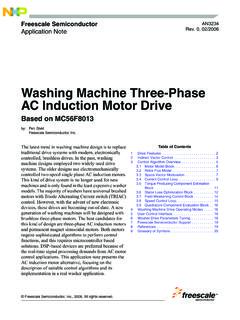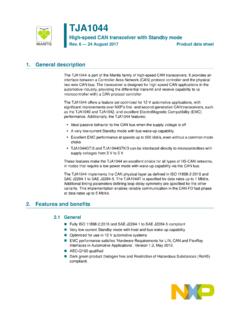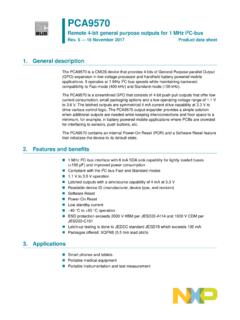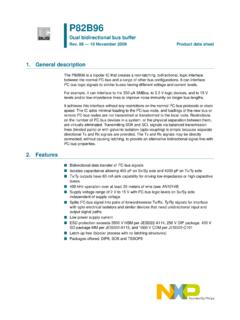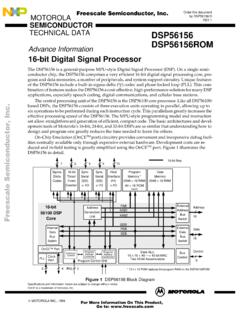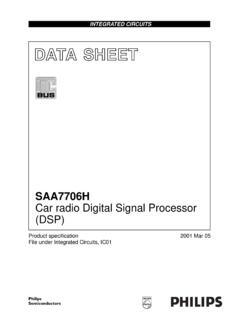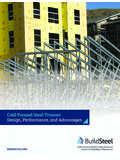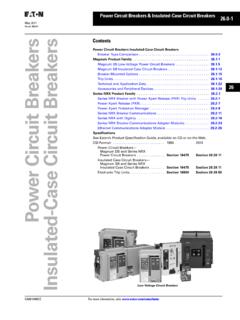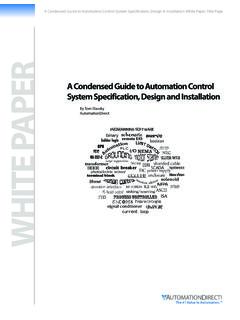Transcription of CHAPTER 6 THERMAL DESIGN CONSIDERATIONS - NXP
1 CHAPTER 6 THERMAL DESIGN CONSIDERATIONS pageIntroduction6 - 2 THERMAL resistance6 - 2 Junction temperature6 - 2 Factors affecting Rth(j-a)6 - 2 THERMAL resistance test methods6 - 3 Test procedure6 - 3 Forced air factors for THERMAL resistance6 - 4 THERMAL resistance data - assumptions and precautions6 - 5 THERMAL resistance (Rth(j-a)) data6 - 6 THERMAL resistance (Rth(j-c)) data tables - power packages6 - 24 April 20006 - 2 Philips SemiconductorsIC PackagesThermal DESIGN considerationsChapter 6 INTRODUCTIONThe ability to describe the THERMAL performancecharacteristics of a semiconductor IC package isbecoming increasingly crucial. With increased powerdensities, improved reliability and shrinking system sizes,the cooling of IC packages has become a challenging taskfor DESIGN engineers.
2 The situation is further exacerbatedby the demand for ever decreasing sizes of electronicdevices because, in general, decreasing the size of anelectronic package decreases the THERMAL designer must carefully balance the benefits ofminiaturization and performance against the potentialreduction in reliability of electronic components resultingfrom high operating RESISTANCEThe ability of a particular semiconductor package todissipate heat to its environment is expressed in terms ofthermal resistance (Rth(j-a)). This single entity describesthe heat path impedance from the active surface of thesemiconductor device (junction) to the ambient operatingenvironment.
3 Rth(j-a) can be expressed by its constituentsas follows:Rth(j-a)=Rth(j-c)+Rth(c-a)Rth(j- c) is the impedance from junction to case (outsidesurface of package) and Rth(c-a) is the impedance fromcase to ambient. It is sometimes useful to use only theRth(c-a) to describe high performance packages wherecase temperatures are important and externally attachedheat radiators may need to be attached. In these cases theoverall Rth(j-a)will also include the contribution of the TEMPERATUREWith the Rth(j-a) of a package known, the rise in junctiontemperature (Tj) with respect to the ambient temperature(Tamb) can be determined at a given power dissipation (Pd)of the semiconductor device:Tj=(Rth(j-a) Pd)+TambWhere:Tj= junction temperature ( C)Rth(j-a)= THERMAL resistance junction to ambient (K/W)Pd= power dissipated (W)Tamb= ambient temperature ( C)It s important to note that a lower Rth(j-a)indicates a higherthermal AFFECTING Rth(j-a)There are several factors which affect the characteristicthermal resistance of IC packages.
4 Some of the moresignificant of these include the test board configuration,the lead frame material, the DESIGN of the lead frame andthe moulding board ConfigurationAn IC package s THERMAL resistance highly depends on thePrinted Circuit Board (PCB) on which the package ismounted. The copper traces and THERMAL vias on the PCBprovide the major heat dissipation path of the package,therefore the configuration and the size of the coppertraces play a significant role in affecting Rth(j-a). For testpurpose, JEDEC standards (EIA/JEDEC51-3 and others)specify two categories of test boards: low effective thermalconductivity test board (low K board) and high effectivethermal conductivity test board (high K board).
5 The low Kboard is a single sided board with only fine signal traces,the high K board is a board with two signal layers and twopower (or ground) layers. The real application board isalmost always different from the standard test boards,however, the THERMAL resistance measured from thestandard test board provides basic comparableinformation of the IC package THERMAL Frame MaterialThe lead frame material is one of the more importantfactors in IC package THERMAL resistance. In early dualin-line packages (DIPs), a Ni/Fe alloy (A42) was thematerial of choice for lead frames as it provided a goodcombination of strength and formability as well asassembly process compatibility.
6 However, with thecontinued miniaturization of IC packages and the need forincreased electrical conductivity for advanced ICs, aswitch to sophisticated copper alloys was alloy lead frames offer several advantages overA42: they have a high THERMAL conductivity which reducesthermal resistance, essential for packages such as theShrink Small Outline Package (SSOP) and Thin ShrinkSmall Outline Package (TSSOP) their improved electrical conductivity enhances theelectrical performance of a packageMost plastic encapsulated packages produced by PhilipsSemiconductors incorporate copper alloy lead frames intotheir 20006 - 3 Philips SemiconductorsIC PackagesThermal DESIGN considerationsChapter 6 Lead Frame DesignThe DESIGN of a lead frame is another significantcontributing factor to THERMAL resistance.
7 The mostimportant DESIGN aspect is the IC attach-pad size and tiebar DESIGN . However, the lead frame designer is oftenfaced with fixed parameters such as die size and wirebonding limitations, which reduce lead frame CompoundMoulding compounds also determine IC package thermalresistance. The mould compounds used by PhilipsSemiconductors are optimized for high purity and quality toprovide good THERMAL performance and SpreadersThe option of a heat spreader, or heat slug, within somepackages can improve THERMAL behaviour by spreading theheat over a larger area of the package, and so improveRth(j-a) or Rth(j-c).Adhesive and Plating TypeOther package related factors include die attach adhesiveand lead frame plating type, but the actual influence onthermal resistance is small owing to the fine geometry ofthese RESISTANCE TEST METHODSP hilip Semiconductors uses what is commonly called theTemperature Sensitive Parameter (TSP) method whichmeets EIA/JEDEC Standards EIA/JESD51-1,EIA/JESD51-2 and EIA/JESD51-3.
8 A typical test fixture instill air is shown in The enclosure is a box with aninside dimension of 1 ft3 ( m3). The enclosure andfixtures are constructed from an insulating material with alow THERMAL conductance, and all seams thoroughly sealedto ensure there is no airflow through the enclosure. The ICpackage is then positioned in the geometric center of forward voltage drop of a calibrated diodeincorporated into a special IC is used to correlate ajunction temperature change in the IC package to betested. As the power dissipation is known, the thermalresistance can be calculated using the following equation:Where:Rth(j-a)= THERMAL resistance junction to ambient ( C/W)Tj= junction temperature ( C)Pd= power dissipated (W)Tamb= ambient temperature ( C)TEST PROCEDUREThe TSP diode on the semiconductor device is calibratedusing a constant temperature oil bath and a constantcurrent power supply (see ).
9 Calibration temperaturesare typically 25 C and 100 C with a measured accuracyof C. The calibration current must be kept low andconstant to avoid significant junction heating. Thetemperature coefficient (K-factor) shown in iscalculated using the following equation:Where:K= temperature coefficient ( C/mV)T2= high test temperature ( C)T1= low test temperature ( C)VF2= forward voltage at T2 (mV)VF1= forward voltage at T1 (mV) The test fixture in still air. PackageCablesMSC599 BoxSubstrateThermocoupleRth j a () TjPd---------TjTamb ()Pd-----------------------------==KT2T1 ()VF2VF1 ()------------------------------=April 20006 - 4 Philips SemiconductorsIC PackagesThermal DESIGN considerationsChapter 6 With the K-factor determined, Rth(j-a)can be calculated bypowering up the device at ambient conditions andmeasuring the forward voltage drop across the TSP diodeafter temperature equilibrium.
10 Manipulating the originalthermal resistance equation with the K-factor, the Rth(j-a)ofthe package can be Test , halfpageMSB474 VFIFD = ON DIE TSPDIODEDOIL BATHMAINTAINEDAT CONSTANTTEMPERATUREI = VF as a function of , halfpageMSB473VF1V (V)FVF2T1T2T ( C)joRth j a () TjPd---------TjTamb ()Pd-----------------------------KVF amb()VFs() ()VHIH ---------------------------------------- --------===Where:VF(amb)= forward voltage of TSP at ambienttemperature (mV)VF(s)= forward voltage of TSP at steady-statetemperature (mV)VH= heating voltage (V)IH= heating current (A)FORCED AIR FACTORS FOR THERMAL RESISTANCEMany applications with ICs have the benefit of forced aircooling by fans or other means.
